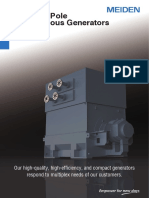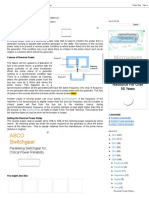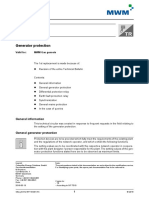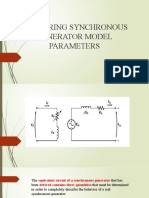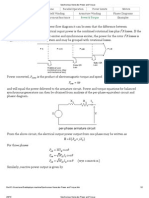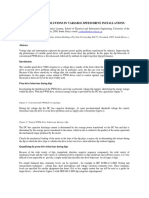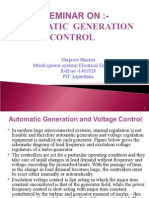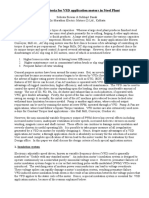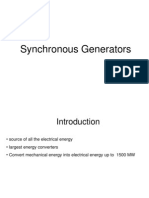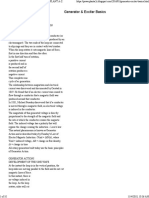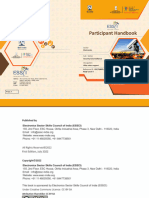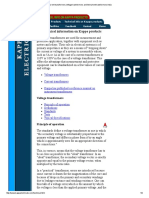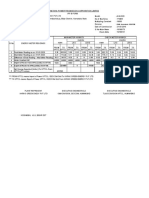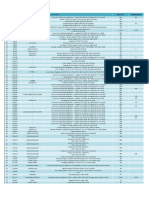Electrical Theory
Generator Theory
PJM State & Member Training Dept.
PJM2016
01/05/2016
�Objectives
The student will be able to:
Describe the process of electromagnetic induction
Identify the major components of an AC generator
Apply the formula for rotational speed
Describe generator governor control
Discuss the characteristics that affect or limit generator performance
Describe MVAR and MW flow
Describe the synchronization process of a generator
PJM2016
01/05/2016
�Basic Operating Principles
Electromagnetic Induction is the principle used by a generator to
convert mechanical energy into electrical energy
For this to happen, three things are needed:
A magnetic field
A current-carrying conductor
A relative motion between the two
This is the fundamental operating principle of generators, motors,
transformers, inductors, and solenoids
PJM2016
01/05/2016
�Basic Operating Principles
Generators use energy from the prime mover to turn the generators rotor
(moving portion) inside the generators stator (static portion)
Steam in a fossil or nuclear unit
Water flow in a hydroelectric unit
Fuel flow in a combustion turbine unit
Wind flow in a wind generator
A DC current flows through the field windings of the rotor creating a
magnetic field
As the rotor spins, it acts via electromagnetic induction to induce a voltage
in the armature windings of the stator
PJM2016
01/05/2016
�Basic Operating Principles
Output voltage of the generator is controlled by changing the strength of
the magnetic field of the rotor
This is accomplished by controlling the amount of direct current (DC) or
excitation current that is supplied to the rotors field winding
The excitation current is supplied by the exciter
The stators output to the system is a three-phase alternating current (AC)
since the direction of the magnetic field changes in relation to the windings
as the rotor turns 360 degrees
One rotation is equal to a complete cycle of power
PJM2016
01/05/2016
�Basic Operating Principles
Bismark Phasor Sim
PJM2016
01/05/2016
�Basic Operating Principles
PJM2016
01/05/2016
�A.C. Generator Components: Rotor
Rotating Magnetic Field
Series of Conductors
PJM2016
01/05/2016
�A.C. Generator Components: Rotor
The basic function of the rotor is to produce a magnetic field of the size and
shape necessary to induce the desired output voltage in
the stator
The rotating field is required to produce a given number of lines of
magnetic flux which is obtained by: Ampere-turns
Ampere-turns is the product of the number of turns in the rotor winding
and the current that flows in the winding
PJM2016
01/05/2016
�A.C. Generator Components: Rotor
Generator rotors are made of solid steel forgings with slots cut along the
length for the copper windings
Insulated winding bars are wedged into the slots and connected at each
end of the rotor and are arranged to act as one continuous wire to develop
the magnetic field
PJM2016
10
01/05/2016
�A.C. Generator Components: Rotor
Two types of rotors:
Salient-pole
Used in low or moderate speed machines with separate field coils
Speeds from 100 to 1,200 rpm
Primarily for hydroelectric facilities
Cylindrical
Used in high-speed machines that utilize a slotted integral forging
Speeds 1,200 rpm and above
Primarily used for steam and combustion turbine facilities
PJM2016
11
01/05/2016
�A.C. Generator Components: Rotor
Rotor design constraints include:
Temperature:
Ampere-turn requirements for the field increase with an increase in rating,
which entails a combined increase in heating in the coil
Mechanical force:
Ampere-turn requirements for the field increase with an increase in rating
causing a higher centrifugal load
Electrical insulation:
In older units, slot insulation is a primary thermal barrier, and as current
increases, becomes a greater obstacle
PJM2016
12
01/05/2016
�A.C. Generator Components: Rotor
Advantage:
Air gap between the stator and rotor can
be adjusted so that the magnetic flux can
be sinusoidal including the waveform
Salient Pole Three Phase Synchronous Generator
Disadvantage:
Because of its weak structure it is not
suitable for high-speed generation
It is also expensive to fabricate
Requires damper windings to prevent
rotor oscillations during operations
Due to low speed, they are constructed
with a higher number of poles to achieve
system frequency
PJM2016
13
01/05/2016
�A.C. Generator Components: Rotor
Advantage:
Cheaper than a salient-pole
Its symmetrical shape, is better
for high-speed application
Losses in the windings are reduced
Noise produced is less
Cylindrical Rotor Synchronous Generator
Disadvantage:
Air gap is uniform
Generated voltage is polygonal
giving way to the susceptibility
of harmonics
PJM2016
14
01/05/2016
�A.C. Generator Components: Rotor
PJM2016
15
01/05/2016
�A.C. Generator Components: Stator
PJM2016
16
01/05/2016
�A.C. Generator Components: Stator
The stator is the stationary part of the generator that is comprised
of a series of stationary windings or poles(phases)
Basic function of the stator core is to provide a return path for the
lines of magnetic flux, and support the coils of the stator winding
The stator core is made of soft iron to provide the magnetic field
path with a high permeability
The iron is laminated to reduce eddy currents (opposing field) and
hysteresis (power losses)
PJM2016
17
01/05/2016
�A.C. Generator Components: Stator
Two-Pole Generators:
In a two-pole generator, there are three armature winding
coils installed in the stator
North and south poles of the rotor are 180 apart
Four-Pole Generators:
In a four-pole generator, there are six armature winding coils
installed in the stator
North and south poles of the rotor are 90 apart
A generator which is connected to the grid has a constant speed
dictated by grid frequency
Bismark AC Generator Sim
PJM2016
18
01/05/2016
�A.C. Generator Components: Exciter
PJM2016
19
01/05/2016
�A.C. Generator Components: Exciter
The function of the excitation system is to provide direct current for
the generator rotor/field windings through slip rings to produce the
magnetic field
Maintains generator voltage, controls MVAR flow, and assists in
maintaining power system stability
During load changes or disturbances on the system, the exciter must
respond, sometimes rapidly, to maintain the proper voltage at the
generator terminals
PJM2016
20
01/05/2016
�Generator Rotational Speed
Frequency is dependent on:
Number of field poles
Speed of the generator
f = (N)(P)/120, where
f = frequency (Hz)
N = rotor speed (rpm)
P = total number of poles
120 = Conversion from minutes to seconds and from poles to pole pairs
(60 seconds/1 minute) x (2 poles/pole pair)
PJM2016
21
01/05/2016
�Generator Rotational Speed
Example: 2 Poles
60 Hz = (3600 RPM)(2 Poles)/120
PJM2016
22
01/05/2016
�Generator Rotational Speed
Example: 4 Poles
60 Hz = (1800 RPM)(4 Poles)/120
PJM2016
23
01/05/2016
�Generator Governor Control
Governors control generator shaft speed
Adjust generation for small changes in load
Operate by adjusting the input to the prime mover
Steam flow for fossil
Water flow for hydro
Fuel flow for combustion turbine
Amount of governor control varies according to plant design
Equivalent to a cars cruise control
PJM2016
24
01/05/2016
�Generator Governor Control
The Watt centrifugal governor was the mechanical means for
governor control
Used weights that moved radially as rotational speed increased
that pneumatically operated a servo-motor
Electrohydraulic governing has replaced
the mechanical governor because of:
High response speed
Low deadband
Accuracy in speed and load control
PJM2016
25
01/05/2016
�Generator Governor Control
PJM2016
26
01/05/2016
�Generator Governor Control
Frequency Response
Load
Rate of frequency decline from points
A to C is slowed by load rejection
Generators
Generator governor action halts the
decline in frequency and causes the
knee of the excursion, and brings the
frequency back to point B from point C
It is important to note that frequency will not recover from point B to 60 Hz
until the deficient control area replaces the amount of lost generation
PJM2016
27
01/05/2016
�Generator Governor Control: Droop
Adding a droop characteristic to a governor forces generators to
respond to frequency disturbances in proportion to their size
Droop settings enable many generators to operate in parallel while
all are on governor control and not compete with one another for
load changes
PJM2016
28
01/05/2016
�Generator Governor Control: Droop
PJM2016
29
01/05/2016
�Generator Governor Control: Droop
PJM2016
30
01/05/2016
�Generator Governor Control: Deadband
Deadband
An additional feature displayed by governors
The amount of frequency change a governor must see before it
starts to respond
Really a natural feature of the earliest governors caused by
friction and gear lash (looseness or slop in the gear mechanism)
Serves a useful purpose by preventing governors from
continuously hunting as frequency varies ever so slightly
PJM2016
31
01/05/2016
�Generator Characteristics
Generator limitation factors
Power capability of the prime mover
Heating of generator components (I2R losses)
Necessity to maintain a strong enough magnetic field to transfer power
from the rotor to the generator output
PJM2016
32
01/05/2016
�Generator Characteristics
Heating of generator components
Heat generated within the armature and field windings is directly
related to the magnitude of current flowing through them
Generator losses:
Based on resistance of the field winding of the rotor
Based on resistance and inductive reactance of the armature windings of the
stator causing a voltage drop that subtracts from the output voltage
Heat dissipated by the generator is limited by the cooling system design
PJM2016
33
01/05/2016
�Generator Characteristics
Magnetic field strength
Controlled by excitation voltage
If excitation voltage is lowered:
Voltage induced in A.C. windings is lowered
More VARS absorbed by generator from system
Undervoltage can cause overcurrent conditions in the stator and lead to
armature or stator heating
Capability curves provide Max/Min limits
PJM2016
34
01/05/2016
�Capability Curve
PJM2016
35
01/05/2016
�Nameplate Data
Main Generator Nameplate Characteristic Data
Rated Output
496,000 kVA
Rated Voltage
22,000 v
Rated Stator Current
13,017 amps
Rated Field Current
3,017 amps
Power Factor
0.9
Poles
Phases
Electrical Connection
Wye
Rated Speed
3,600 RPM
Rated Frequency
60 Hz
Rated Hydrogen Pressure
48 psig
Rated Hydrogen Purity
97%
PJM2016
36
01/05/2016
�Generator Capability Curve
The steady-state capability of a generator as it is influenced by the power
factor is divided into three major components on the curve
Region A-B: Zero power factor lagging to rated power factor
Generator is over-excited
Field current is at rated value
Capability limitation is field overheating
Region B-C: Rated power factor lagging through unity to 0.95 power factor
leading
Capability limitation is dependent on the stator current
Maximum nameplate stator amperes should not be exceeded
PJM2016
37
01/05/2016
�Generator Capability Curve
Region C-D: leading power factor operation
Excessive heating in the stator end-iron due to flux
leakage from the core
Capability limitation is end-iron heating
This is also an underexcitation region and capability is further reduced
by the voltage squared during reduced terminal voltage operation
PJM2016
38
01/05/2016
�Generator MW Flow & Power Angle
Power Angle
PJM2016
39
01/05/2016
�Generator MW Flow & Power Angle
Rotor Angle
On a transmission system is similar to rotor angle
Load or Torque angle
No Load
Field pole of rotor is in phase with stator armature windings
=0
Load Added
Rotor advances with respect to the stator
MWs flow out of the machine
Bismark Torque Angle Sim
PJM2016
40
01/05/2016
�Generator Synchronization
Synchronization is the process of precisely coordinating or
matching two or more activities, devices, or processes in time
Synchronization, in the electric industry, is the process of
matching the speed, frequency, and voltage of a generator or
other source to a running network
Conditions must be met to prevent unwanted and excessive
energy flows when paralleling
PJM2016
41
01/05/2016
�Generator Synchronization
The objective of synchronization is to match speed and phase
position so there is little or no transfer of energy when paralleling a
unit to a system or two systems
Voltage Magnitude (MVAR)
Frequency Magnitude (MW)
Phase Angle Deviation (MW)
Phase Sequence (Current)
PJM2016
42
01/05/2016
�Generator Synchronization
Manual synchronizing is performed by plant or field operators by manually
adjusting frequency and voltage of the generator or area to be paralleled
and ultimately closing the circuit breaker to tie the incoming system to
the running system
For manual synchronization, meter panels are used to
provide information
Individual bus and generator frequency meters
Individual bus and generator AC voltmeters
Synchroscope
Two indicating lamps
PJM2016
43
01/05/2016
�Generator Synchronization
Synchroscope is a multiple parameter information source
Indicates a frequency difference between the generator or area
and the running system (slip rate)
Indicates if the generator or area frequency is running slower
or faster than the running area
Indicating incandescent lamps demonstrate that the incoming
and running system are in phase
Bismark Synch Lab
PJM2016
44
01/05/2016
�Generator Synchronizing
Voltage
Frequency
Phase Angle
PJM2016
45
01/05/2016
�Summary
Defined electromagnetic induction and how mechanical energy is converted into
electrical energy
Explained the major components of an AC Generator
Applied the formula for generator rotational speed
Described generator governor control to include the droop and
deadband characteristics
Described generator characteristics that can limit the performance of
a generator
Described MVAR and MW flow
Described the process of synchronizing a generator to the system
PJM2016
46
01/05/2016
�Questions?
PJM Client Management & Services
Telephone: (610) 666-8980
Toll Free Telephone: 866-400-8980
Website: www.pjm.com
The Member Community is PJMs self-service portal for members to search for answers to their questions
or to track and/or open cases with Client Management & Services
PJM2016
47
01/05/2016
�Resources and References
Rustebakke, Homer M. (1983). Electric Utility Systems and Practices.
New York: John Wiley and Sons
Miller, Robert H., & Malinowski, James H. (1993). Power System Operation.
New York: McGraw-Hill Inc.
PJM2016
48
01/05/2016





